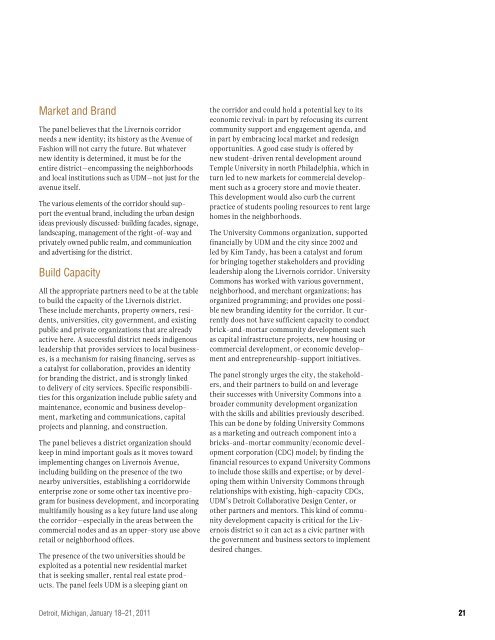Detroit Michigan
Detroit Michigan
Detroit Michigan
Create successful ePaper yourself
Turn your PDF publications into a flip-book with our unique Google optimized e-Paper software.
Market and Brand<br />
The panel believes that the Livernois corridor<br />
needs a new identity; its history as the Avenue of<br />
Fashion will not carry the future. But whatever<br />
new identity is determined, it must be for the<br />
entire district—encompassing the neighborhoods<br />
and local institutions such as UDM—not just for the<br />
avenue itself.<br />
The various elements of the corridor should support<br />
the eventual brand, including the urban design<br />
ideas previously discussed: building facades, signage,<br />
landscaping, management of the right-of-way and<br />
privately owned public realm, and communication<br />
and advertising for the district.<br />
Build Capacity<br />
All the appropriate partners need to be at the table<br />
to build the capacity of the Livernois district.<br />
These include merchants, property owners, residents,<br />
universities, city government, and existing<br />
public and private organizations that are already<br />
active here. A successful district needs indigenous<br />
leadership that provides services to local businesses,<br />
is a mechanism for raising financing, serves as<br />
a catalyst for collaboration, provides an identity<br />
for branding the district, and is strongly linked<br />
to delivery of city services. Specific responsibilities<br />
for this organization include public safety and<br />
maintenance, economic and business development,<br />
marketing and communications, capital<br />
projects and planning, and construction.<br />
The panel believes a district organization should<br />
keep in mind important goals as it moves toward<br />
implementing changes on Livernois Avenue,<br />
including building on the presence of the two<br />
nearby universities, establishing a corridorwide<br />
enterprise zone or some other tax incentive program<br />
for business development, and incorporating<br />
multifamily housing as a key future land use along<br />
the corridor—especially in the areas between the<br />
commercial nodes and as an upper-story use above<br />
retail or neighborhood offices.<br />
The presence of the two universities should be<br />
exploited as a potential new residential market<br />
that is seeking smaller, rental real estate products.<br />
The panel feels UDM is a sleeping giant on<br />
<strong>Detroit</strong>, <strong>Michigan</strong>, January 18–21, 2011<br />
the corridor and could hold a potential key to its<br />
economic revival: in part by refocusing its current<br />
community support and engagement agenda, and<br />
in part by embracing local market and redesign<br />
opportunities. A good case study is offered by<br />
new student-driven rental development around<br />
Temple University in north Philadelphia, which in<br />
turn led to new markets for commercial development<br />
such as a grocery store and movie theater.<br />
This development would also curb the current<br />
practice of students pooling resources to rent large<br />
homes in the neighborhoods.<br />
The University Commons organization, supported<br />
financially by UDM and the city since 2002 and<br />
led by Kim Tandy, has been a catalyst and forum<br />
for bringing together stakeholders and providing<br />
leadership along the Livernois corridor. University<br />
Commons has worked with various government,<br />
neighborhood, and merchant organizations; has<br />
organized programming; and provides one possible<br />
new branding identity for the corridor. It currently<br />
does not have sufficient capacity to conduct<br />
brick-and-mortar community development such<br />
as capital infrastructure projects, new housing or<br />
commercial development, or economic development<br />
and entrepreneurship-support initiatives.<br />
The panel strongly urges the city, the stakeholders,<br />
and their partners to build on and leverage<br />
their successes with University Commons into a<br />
broader community development organization<br />
with the skills and abilities previously described.<br />
This can be done by folding University Commons<br />
as a marketing and outreach component into a<br />
bricks-and-mortar community/economic development<br />
corporation (CDC) model; by finding the<br />
financial resources to expand University Commons<br />
to include those skills and expertise; or by developing<br />
them within University Commons through<br />
relationships with existing, high-capacity CDCs,<br />
UDM’s <strong>Detroit</strong> Collaborative Design Center, or<br />
other partners and mentors. This kind of community<br />
development capacity is critical for the Livernois<br />
district so it can act as a civic partner with<br />
the government and business sectors to implement<br />
desired changes.<br />
21


